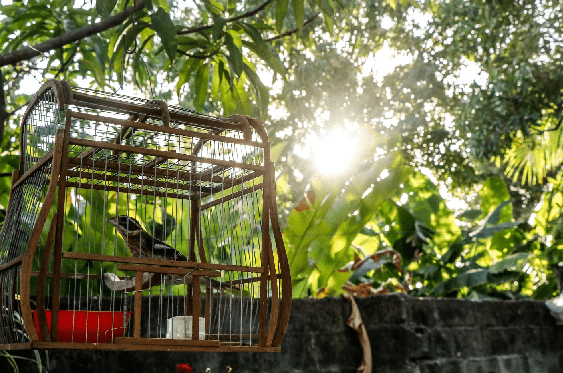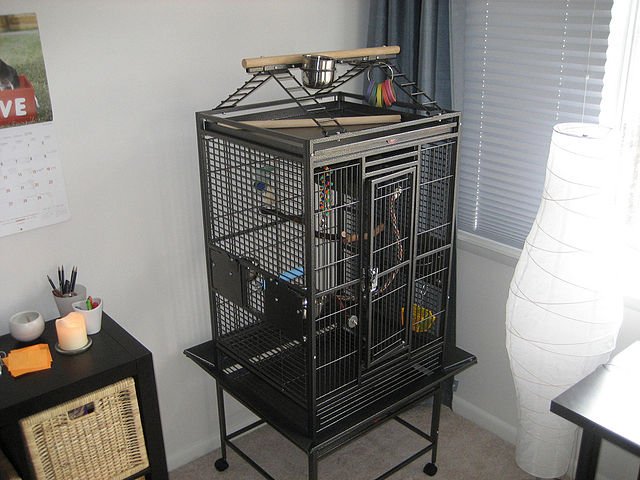The popularity of Quaker parrots is increasing enormously with bird-lovers all over the world. Quakers are extremely social birds and survive in the wild by developing colonies. So, keeping their interactive needs in mind, we need to provide them enough company when we bring them home to a cage or aviary as our babies.
Either bring a pair or be ready to satisfy their socializing needs by devoting enough time to them. Just the way we prepare a little home in the form of a baby cot for our human babies, we need to make a room for our baby birds as well. Such a new home can be in the form of a simple cage or an aviary cage which is much larger in size than the normal one.
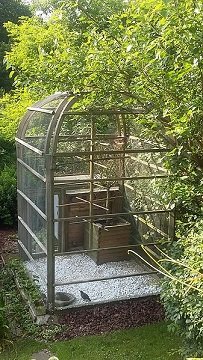
These aviaries will improve the quality of life of your pets as there will be more room for them to roam around and play. As they will have ample free space, your parrots will feel happier in an aviary than in a little cage.
Building Quaker parrot Aviary
As a starting point to establishing an aviary for your quaker parrot, it would be ideal to measure the area you have chosen for your pet as his new home. You shouldn’t restrict him to limited space as he needs to fulfill his flight needs and requires physical activity to remain healthy.
Size of Aviary For quaker parrot
Some good size of Aviary for medium size parrots like Quaker parrot is 3m length, 1m width, and 2m height. It has enough space for a parrot to fly, and feel relaxed and comfortable. Of course, you should take number of parrots into consideration, even thou Quaker parrots are social birds and don’t mind other Quaker parrots in the big aviary.
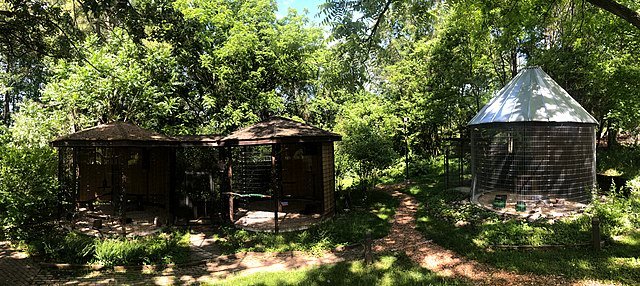
Your pet also demands a little comfortable roosting space to get ready with all the energy again for the following day’s fun-filled activities. If you have brought home a pair or more than two babies, make sure that there is enough space for each of them.
It would be detrimental to these delicate beauties to thrive cheerfully in a restricted space. In such a scenario, there also arises a need to build a separate compartment inside the aviary for each bird if they are strangers to each other. Once they develop a good bond, it is safe to house them together without any partitions in the aviary.
Material For building Parrot Aviary
The other important thing to consider is the material the aviary should be made of. Your little quaker loves wood and will destroy the aviary while playing with it if his house has wooden walls. Also check for the use of any metals, like copper or zinc, in the making of the aviary as they can cause metal poisoning to your pet and are thus, very harmful for his health. The safer material for his home would include steel and iron.
You also need to decide upon the floor material of the aviary, if you plan to set it up at an outdoor location. Consider using the one you can easily clean up to avoid inviting mites and germs into your pet’s home. A hard surface like concrete should be chosen over tiles or carpets.
You can easily wipe away all the dirt from a hard floor, but it is impossible to do so from one covered with carpet. On the other hand, dust will get collected in between the tiles, if used. Please don’t use sand or gravel over a wire mesh as an aviary floor, since it can cause an unnecessary predator’s entry into your quaker parrot’s place.
Keeping your parrot’s place safe, airy, and germ-free should be your main criterion in deciding upon the aviary material.
Setting up your quaker Parrot Aviary
The next part involves filling up the aviary with the appropriate things for your little one’s requirements. You can place some natural branches inside the aviary for perches. Create a mix of high and low perches so that your pet can enjoy flying from one to another. It will also serve as physical exercise for him.
Replace these perches from time to time as your quaker will chew them all up! Keep some non-toxic leafy branches in the aviary as chewable which will act as beak-exercisers for him along with another source of entertainment.
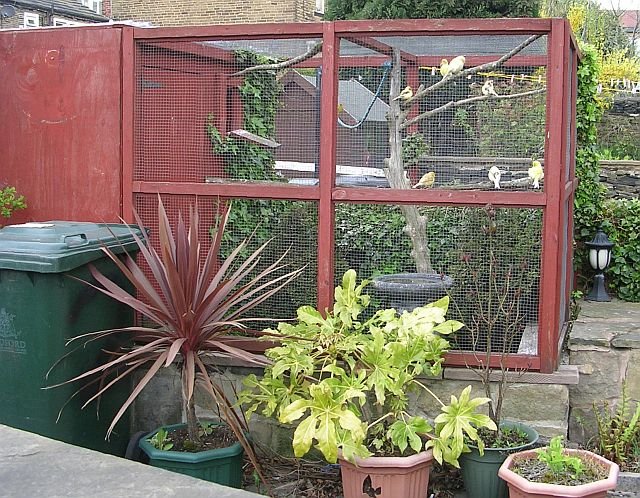
Building Nests inside Aviary
Your Quaker Parrot doesn’t like to build a nest in a tree-trunk rather he makes it up with twigs and branches. You shall consider placing nest boxes inside the aviaries for your pet’s nesting needs. In the beginning, offer nest boxes in various sizes at different locations within the aviary.
Once he chooses a specific box, you can safely remove the remaining boxes and use them to give options to your other baby birds after cleaning them thoroughly. Place twigs and sticks in small quantities inside the aviary, so that your quaker can use it up as his nesting material inside the nest box he has chosen for himself. Ensure to add more nesting material once he uses all of it. Decomposed saw-dust or wood-shavings could be used for this purpose.
With time, your quaker might feel more domesticated and do away with the need of creating a nest for himself. If you have brought him home at a pretty little age, you can do away with this requirement as he hasn’t yet built-up a habit of making nests. You can also do away with this step if your baby parrot was domesticated earlier and has never made any such nests.
Food and water in the aviary
Other needs of your pet baby include water and food requirements daily. You need to set up a water container in the aviary and fill it up regularly. Make sure to offer more water on sunny days to your parrots.
Similarly, you also need to establish a food container in your quaker parrot’s home. Fill it up with fruits, vegetables, nuts, cuttle-bone, and his favorite sprouted seeds regularly.
Should you buid aviary indoor or outdoor?
Depending on your individual choice, you can consider setting up the aviary either indoor or outdoor. There are positives and negatives in both cases.
Indoor aviary
An indoor aviary is suitable for your parrot in cases of harsh climates like chilly weather conditions or super-sunny days. You will be able to interact with your baby while doing your household chores which will make your bond all the more strong. His chirps and songs will also remain within your household walls which is pretty much essential in case you live with sensitive neighbors.
Outdoor Aviary
On the contrary, you can opt for an outdoor aviary for your pet if you live in the area with moderate climatic conditions. He will receive enough vitamin D boost in the most natural form directly from the sun outside.
You need to make sufficient arrangements for rainy days to protect your parrot from catching up on any illnesses. He is also exposed to a host of pathogens, like bacterial diseases or avian flu when housed outside for longer periods.
To protect your baby from these risks outside, you need to take extra care for cleaning the aviary and get his medical check-ups done at regular intervals of time. This will ensure timely treatment for any such illnesses caught by the pet.
Before you decide on the location for your parrots’ house, I would like to present an idea to get the best of both worlds for him. Just go for an aviary with wheels and let them roll!
Should you buy an aviary, or make one DIY
The other thing that we all usually think of is whether to purchase an aviary or build one on our own. Before you even think of creating a structure for aviary, do check out all the legal requirements in your area and take proper permissions from the local authorities, if required.
You can then start building a structure of your choice keeping in mind the space and facilities you want to provide to your little one. In case you take care of multiple Quakers at the same time, make a structure large enough to avoid overcrowding.
Make proper enclosures so that your parrot doesn’t leave the aviary without you and also to block the entry of predators into the structure. Don’t forget the construction of a solid floor to keep snakes at bay. Keep a check on all the wire mesh that you used in making the aviary for any holes or loose ends. You don’t want your Quaker parrot to be a target for cats or dogs.
Buying ready Aviary
Contrarily, purchasing a ready-made aviary is a much safer option due to the use of harder materials like steel or iron in place of wire mesh used in a home-built one. The best option to provide all the facilities along with safety to your little companion would be to customize a store-bought aviary as per your desires.
In whatever way you build that sweet home for your quaker parrot, keep his safety and comfort your priority. You are blessed to take care of a little life and his wellness is your responsibility.
Whether housed indoors or outdoor, consult a vet at regular intervals of time to determine your baby’s physical as well as mental health. Spend as much time with him as you can to make him feel happy. His happiness finds a way to yours automatically.
If you still decide for Cage, check out our Amazon offer


